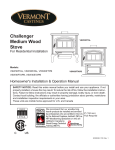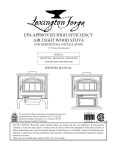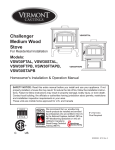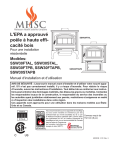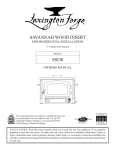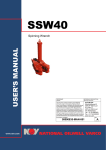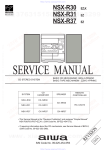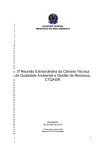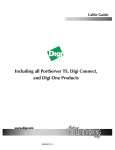Download Vermont Castings Challenger VSW40 Specifications
Transcript
Challenger Large Wood Stove For Residential Installation Owners Manual Model: VSW40 6" (152 mm) Flue Required 634001Read this entire manual before you install and use your appliance. If not propSAFETY NOTICE: cover erly installed,SSW20 a house fire may result. To reduce the risk of fire, follow the installation instructions. Failure to follow instructions may result in property damage, bodily injury, or even death. Contact local building, fire officials or authorities having jurisdiction about permits, restrictions and installation inspection requirements in your area. These units are mobile home approved for U.S. and Canada 20300060 7/09 Rev. 1 VSW40 Wood Stove CONTENTS INSTALLER OWNER Please leave these instructions with the appliance. Please retain these instructions for future reference. IMPORTANT Read these instructions carefully before installing or trying to operating this woodburning appliance. TABLE OF CONTENTS ACCESSORIES Specifications............................................................... 3 Questions?.................................................................... 4 Pre-installation instructions........................................... 5 Stove set-up.................................................................. 6 Clearances.................................................................... 8 Installation..................................................................... 9 Operation......................................................................11 Maintenance................................................................ 12 Replacement parts...................................................... 15 FAQs........................................................................... 16 Warranty...................................................................... 19 Variable Speed Blower Gold Legs Gold Door Trim Nickel Legs Nickel Door Trim BLOTWS SSW30CLGD SSW30GDTK SSW30CLN SSW30NDTK WARNING Proposition 65 Warning Fuels used in gas, woodburning or oil fired appliances, and the products of combustion of such fuels, contain chemicals known to the State of California to cause cancer, birth defects and other reproductive harm. California Health and Safety Code Sec. 25249.6 20300060 VSW40 Wood Stove SPECIFICATIONS Stove dimensions 276M” (705 mm) 3356M” (845 mm) 3156O” (800 mm) 2656O” (673 mm) 23” (584 mm) 32” (813 mm) Log Length 22" (559 mm) Maximum burn time2 13 hours 634002 Average area heated (sq.ft)2 3,000 sq. ft. SSW40 DIMS Range of heat output3 12,000-36,000 10/08 Maximum heat output1 75,000 EPA emissions rating (g/h, non-catalytic) 4.3 gph Weight 520 lbs Loading Front Air Control Manual 1.Maximum burn times and heat outputs are based on laboratory testing using full loads of seasoned hardwoods, and may vary in individual use depending on how the stove is operated, type and moisture content of fuel, and other factors. Maximum burn times are achieved under different operating conditions than are maximum heat outputs. 2.These values are based on operation in building code-conforming homes under typical winter climate conditions in the U.S. If your home is of nonstandard construction (e.g. unusually well-insulated, not insulated, built underground, or if you live in a more severe and more temperate climate), these figures may not apply. Since so many variables affect performance, consult your Vermont Castings Authorized Dealer to determine realistic expectations for your home. 3.Under specific conditions used during EPA emissions testing. 60300060 VSW40 Wood Stove QUESTIONS? Need to ask questions? Require Parts Information? First, contact the Vermont Castings Dealer from whom you purchased your stove, for parts and service. Have the following information ready: • Date of purchase • Serial number (from the back of your stove) • Model number (from the back of your stove) • Dealer name and phone If you still need assistance, contact Vermont Castings technical support (below). Wondering about the warranty? See the last page of this manual for general warranty information. For additional information, contact your Vermont Castings dealer or Vermont Castings Parts and warranty. Vermont Castings Technical Service, Parts & Warranty Phone: 877-406-9180 Fax: 877-406-5647 Model and product serial numbers can be found on the certification label of your stove. BEFORE INSTALLATION OF YOUR APPLIANCE WHY THE CORRECT FLUE SIZE IS IMPORTANT — 6" (152 mm) 1. Check with the building inspector’s office for compliance with local codes; a permit may be required. 2. This appliance requires a masonry or prefabricated chimney listed to ULC S629 (Canada) and UL 103HT (U.S.) sized correctly. 3. A 6" (152 mm) diameter flue is required for proper performance. 4. Always connect this unit to a chimney and NEVER VENT TO ANOTHER ROOM OR INSIDE A BUILDING. 5.DO NOT connect this unit to any duct work to which another appliance is connected such as a furnace. 6.DO NOT connect this unit to a chimney flue serving another appliance. 7. The connector pipe and chimney should be inspected periodically and cleaned if nescessary. 8. Remember the clearance distances when you place furniture or other objects within the area. DO NOT store wood, flammable liquids or other combustible materials too close to the unit. Refer to certification label on back of your unit for required clearances. 9. Contact your local municipal or provincial fire authority for information on how to handle a chimney fire. Have a clearly understood plan to handle a chimney fire. In the event of a chimney fire, turn air control to closed position and CALL THE FIRE DEPARTMENT. 10.DO NOT tamper with combustion air control beyond normal adjustment. 11. If installing in a mobile home, use mobile home kit. Draft is the force, which moves air from the appliance up through the chimney. The amount of draft in your chimney depends on the length of the chimney, local geography, nearby obstructions, and other factors. Too much draft may cause excessive temperatures in the appliance. An uncontrolled burn, a glowing red part or chimney connector indicates excessive draft. Inadequate draft may cause back puffing into the room and “plugging” of the chimney and/or cause the appliance to leak smoke into the room through appliance and chimney connector joints. Today’s solid fuel appliances are much more efficient than in the past. The units are designed to give you controlled combustion, as well as maximum heat transfer, using less fuel to do so. The design of your new appliance is such that the exhaust “smoke” is now at lower temperatures than in the past, therefore requiring proper chimney size to give adequate draft. If your chimney is too large, the heating appliance will have a difficult time to raise the “chimney flue” temperature to give adequate draft, therefore causing a smoke back up, poor burn, or both. Should you experience such a problem call in a local chimney expert. With the door closed, the rate of burning is regulated by the amount of air allowed to enter the unit through the air control. With experience you will be able to set the control for heat and burning time desired. Once the required chimney draft is obtained, operate only with doors closed and open slowly when re-fueling. (This will reduce or eliminate smoke from entering the room.) 20300060 VSW40 Wood Stove Attempts to achieve higher output rates that exceed heater design specifications can result in permanent damage to the heater. The recommended wood load is level with the top of the firebricks. Overloading may prevent sufficient air entering the heater to properly fuel the fire. CAUTION After reading these instructions, if you have any doubt about your ability to complete your installation in a professional manner, you should obtain the services of an installer versed in all aspects of correct and safe installation. DO NOT use temporary, makeshift compromises during installation. THIS HEATER IS EXTREMELY HOT WHILE IN OPERATION. SERIOUS BURNS CAN RESULT FROM CONTACT. KEEP CHILDREN, PETS, CLOTHING AND FURNITURE AWAY DANGER CAUTION PRE-INSTALLATION INSTRUCTIONS RISK OF ELECTRIC SHOCK. DISCONNECT POWER BEFORE SERVICING UNIT. Important: For optimum heater performance at “low” burn rate, operate the fan at low speed. An outside air kit is available from your Vermont Castings dealer. Optional Blower: 110v 130 CFM Model: BLOTWS • OPERATE THIS HEATER ONLY WITH THE DOOR CLOSED. • DO NOT BURN GARBAGE OR FLAMMABLE • FLUIDS. DO NOT USE CHEMICALS OR FLUIDS TO START THE FIRE. 60300060 VSW40 Wood Stove STOVE SET-UP 1. Check that all brick and tubes are in place. 2. Select the proper location for the stove. These appliances must not be installed any closer than the minimum clearance to combustible materials shown on Page 8 of this manual. The stove must be installed on a non-combustible surface as shown on Page 9 of this manual. 3. Remove packing material and packing labels from glass. FAILURE TO FOLLOW THE MINIMUM CLEARANCE REQUIREMENT AND NON-COMBUSTIBLE SURFACE REQUIREMENTS MAY RESULT IN AN UNSAFE INSTALLATION 4. If non-combustible materials have been installed on the walls, obtain the minimum clearances from either the manufacturer of these materials or the local building inspectors office. 5. Install the stovepipe INSIDE the flue collar on the top of the stove between the stove and chimney. 6.DO NOT use a grate to elevate the fire. STOVE PIPE 1. Make sure your chimney and chimney connector meets safety codes. Check with authorities having jurisdiction in your area. 2. All pipe sections must be connected with the male end (crimped end) toward the stove. 3. Fasten the stove pipe to the flue collar by the use of three sheet metal screws. Do the same at each additional joint to make the entire installation rigid. 4. Maintain the required diameter flue for the entire installation. 5. If you are connecting the stove to an old masonry flue, be sure to have it inspected for cracks and general condition. Resizing with a stainless steel liner may be required. 6. It is recommended that no more than two 90 degree bends be used in the stovepipe installation. More than two 90 degree bends may decrease the amount of draw and possible cause smoke spillage. 7. A damper is not required in this installation. Remove any damper plate in the chimney or secure in the OPEN position. 8. Single wall flue pipe assemblies must not exceed 10 feet (3 meters) in overall length. STOVE SET-UP Notes on Chimney and Stovepipe Insulation: Maintaining a clean chimney is important. Chimneys should be inspected regularly for creosote buildup. A straight chimney is easier to clean than one with 45 or 90 degree bends. A bend requires the pipe to be removed for cleaning. The stove baffle must be removed when cleaning the chimney (see page 15). Chimney sweepings will build up on top of baffle causing a blocked flue and/or a fire hazard. Steel Chimney Most factory made “Class A” steel chimneys have a layer of insulation around the inner flue. This insulation keeps the smoke warm and protects the surrounding structure from the high flue temperatures. Because the insulation is less dense than masonry, the inner steel liner warms up more quickly than masonry chimney; this makes the steel chimney support a good draft more quickly than masonry does. Indoor/Outdoor Location Because the chimney’s function is to keep the smoke warm, it is best to locate it inside the house. This location uses the house as insulation for the flue and allows some radiant heat release form the flue into the home. Since an interior chimney doesn’t continuously lose its heat to the outdoors, less heat from the stove is required to get it warm and keep it warm. Flue Sizing The flue size for a controlled-combustion appliance should be based on the cross-sectional volume of the stove flue outlet. In this case, more is definitely not better. Hot gases lose heat through expansion; if a stove with a six-inch flue collar (28 square inch area) is vented into a 10" x 10" flue, the gases will expand to over three times their original volume. As gases cool with expansion, draft strength decreases. If the oversized flue is also outside the house, the heat it absorbs will be conducted to the outdoor air and the flue will remain relatively cool. It is common for a masonry flue to be oversized for the stove. Such a chimney can take quite a while to warm up, and the stove performance will likely be disappointing. The best solution to an oversize flue problem is the installation of an insulated steel chimney liner of the same diameter as the appliance flue outlet. The liner keeps the exhaust gas warm and the result is a stronger draft. An uninsulated liner is a second choice—although the liner will keep the exhaust restricted to its original volume, the air around the liner will require time and heat energy to warm up. Check your local codes. You may be required to install a flue liner in any oversize masonry flue. 20300060 VSW40 Wood Stove STOVE SET-UP Masonry Chimney Single Venting Although masonry is the traditional material used for chimney construction, it can have distinct performance disadvantages when used to vent a controlled combustion wood stove. Masonry forms an effective “heat sink”—that is, it absorbs and holds heat for long periods of time. Your stove requires a dedicated flue. Do not connect the stove to a flue used by any other appliance. Chimney draft is a natural form of energy and follows the path of least resistance. If the stove is vented to a flue that also serves open replace or another appliance, the draft will also pull air through those avenues. The large mass however, may take a long time to become hot enough to sustain a strong draft. The larger the chimney (in total mass) the longer it will take to warm up. Cold masonry will actually cool exhaust gases enough to diminish draft strength. This problem is worse if the chimney is located outside the home or if the chimney flue has a cross-sectional volume much larger than the stove outlet. The additional airflow will lower the flue temperatures, reduce draft strength and promote creosote development; overall stove performance will suffer. The effect is similar to that of a vacuum cleaner with a hole in the hose. In some extreme instances, the other appliances can even impose a negative draft and result in a dangerous draft reversal. Pipe and Chimney Layout Every bend in the flue will act as a brake on the exhaust as it flows from the firebox to the chimney cap. The ideal pipe and chimney layout is straight up from the stove through completely straight chimney. Use this layout if at all possible, as it will promote optimum stove performance and simplify maintenance. If the stovepipe must elbow to enter a chimney, locate the elbow about midway between the stovetop and the chimney thimble. This configuration lets the smoke speed up before it must turn, keeps some pipe in the room for heat transfer, and allows long-term flexibility for installing a different appliance without relocating the thimble. There should be no more than eight feet of single-wall stove pipe between the stove and a chimney. Longer runs can cool the smoke enough to cause draft and creosote problems. Use double-wall stove pipe for longer runs. 60300060 VSW40 Wood Stove CLEARANCES Clearance to Combustibles (UL-1482 and ULC-s627) Minimum clearance to combustible materials in inches. Note: All “A,” “C,” and “F” dimensions are to the stove pipe. Installation: Full Vertical A B CD E F GH I Single Wall Pipe 15" 10" 26" 15" 8" 20" 50" 18" 8" Flat top model (381 mm) (254 mm) (660 mm) (381 mm) (203 mm) (508 mm) (1270 mm) (457 mm)(203 mm) Double Wall Pipe 13" 8" 23" 12" Flat top model (330 mm) (203 mm) (584 mm) (305 mm) B A C Top Vent out the Back Wall with Minimum 2' Vertical D G E F H I F E ST1008 Figure 1 Clearances to Combustibles ST1008 SSW40 clearances 10/08 20300060 VSW40 Wood Stove INSTALLATION Wall Pass-ThrUs Whenever possible, design your installation so the connector does not pass through a combustible wall. If you must use a wall pass-through in your installation, check with your building inspector before you begin and construct it in accordance with local building codes. Also, check with the chimney connector manufacturer for any specific requirements. Accessories are available from your dealer for use as wall pass-throughs. If using one of these, make sure it has been tested and listed for use as a wall pass-through. All combustible material in the wall is cut away a sufficient distance from the single-wall connector to provide the required 12" (305 mm) clearance for the connector. Any material used to close up the opening must be noncombustible. The following wall pass-through methods may be approved in your area: • Use a section of listed factory-built chimney with a nine-inch clearance to combustibles. Do not connect the heater to any air distribution duct or system. In Canada: The Canadian Standards Association has established different guidelines. Figure 11 shows one method, in which all combustible material in the wall is cut away to provide the required 18" (450 mm) clearance for the connector. The resulting space must remain empty. A flush mounted sheet metal cover may be used on one side only. If covers must be used on both sides, each cover must be mounted on non-combustible spacers at least 1" (25 mm) clear of the wall. Your Vermont Castings dealer or your local building inspector can provide details of other approved methods of passing a chimney connector through a combustible wall. In Canada, this type of installation must conform to CAN/CSA-B365. Installation Code for Solid Fuel Burning Appliances and Equipment. NOTE: Do not vent your stove into a factory-built (zeroclearance) fireplace. These appliances and their chimneys are specifically designed as a unit for use as fireplaces. It may void the listing or be hazardous to adapt them for any other use. • Place a chimney connector pipe inside a ventilated thimble, which is then separated from combustibles by 6" (152 mm) of fiberglass insulating material. • Place a chimney connector pipe inside a section of listed solid-insulated, factory-built chimney, with an inside diameter 1" (51 mm) larger than the chimney connector and having 1" (25 mm) or more of insulation and maintaining a minimum 2 inch air space between the outer wall of the chimney and combustibles. 18" (450 mm) Empty Space All Around the Chimney Connector 12" (305 mm) ST1010 Chimney Connector 12" (305 mm) ST1009 Figure 2 Wall Pass-thru Enclosed with Noncombustible Materials ST1009 wall pass thru 60300060 Sheet Metal Cover (This Side Only) Figure 3 Hollow wall pass-thru ST1010 hollow wall pass thru VSW40 Wood Stove INSTALLATION Floor Protector Installation on a Concrete Floor An appliance mounted on a concrete floor does not require floor protection. Carpeting and any other combustible material shall not cover the floor protector. If a combustible surface is applied to the concrete floor, a clearance must be maintained equivalent to the area reserved for the floor protector. Figure 4 Installation on a Combustible Floor If the appliance is to be installed on a combustible floor or a combustible floor covering, it must be installed on a non-combustible floor protector. The pad must be installed beneath the appliance extending 18" (457 mm) in Canada, 16" (406 mm) in the U.S. on any side equipped with a door, and 8" (203 mm) on all other sides. In the U.S. the pad must cover any horizontal chimney connector runs and extend 2" (51 mm) beyond each side. 3. The chimney should extend at least 3' (914 mm) above the highest point where it passes through the roof, and at least 2' (610 mm) higher than any portion of a building within 10' (3 m). Figure 5 4. The chimney connector shall not pass through an attic, roof space, closet, concealed space, floor, ceiling, wall or any partition of combustible construction. 5. The minimum overall height of your chimney should be 15' (5 m) from the floor. 6. D o n o t u s e m a k e s h i f t c o m p r o m i s e s d u r i n g installation. 0 to 10’ 2’ Min. 0 to 10’ 3’ Min. 2’ Min. 3’ Min. 2” (51 mm) 2” (51 mm) ST1012 Reference Point 8” (203 mm) Figure 5 ST1012 The 2'-3'-10' Chimney Rule 2 3 10 rule 8” (203 mm) 8” (203 mm) * 18” (457 mm) ** 16” (406 mm) ST1059 * Canada ** US Figure 4 Installation on a Combustible Floor ST1059 CHIMNEY SSW20 floor protection Refer to chimney and chimney connector manufacturer’s instructions. Contact your local building authority for approved methods of installation 1. This appliance requires a masonry or pre-manufactured chimney listed to ULCS629 (Canada) and UL 103 HT (USA) sized correctly. 2. If a masonry chimney is used it is advisable to have your chimney inspected for cracks and check the general condition before you install your unit. Re-lining may be required to reduce flue diameter to the appropriate functional size. 10 At the very least, inspect the chimney connector and chimney at least once every two months during the heating season to determine if a buildup of creosote or soot has occurred. If a significant layer of creosote has accumulated (1/8" (3 mm) or more], or if soot has accumulated, either should be removed to reduce the risk of a chimney fire. Failure to keep the chimney and connector system clean can result in a serious chimney fire. The conditions for a chimney fire develop as follows: When wood is burned slowly, it produces tar and other organic vapors which combine with expelled moisture to form creosote. The creosote vapors condense in the relatively cool chimney flue of a slow burning fire. As a result creosote residue accumulates on the flue lining. Creosote is a flammable and, when ignited, make an extremely hot fire within the flue system which can damage the chimney and overheat adjacent combustible material. To reduce the amount of creosote that may form, remember to provide adequate air for combustion and to strive for small, intense fires rather than large smoldering ones. You can never be too safe. Contact your local fire authority for information on what to do in the event of a chimney fire, and have a clearly understood plan on how to handle one. 20300060 OPERATION VSW40 Wood Stove OPERATION Inspect your chimney frequently and clean it whenever accumulation exceeds 1/4". Do not use a grate or elevate fire. Build wood fire directly on firebrick. When the stove is used for the first time the solvents in the paint will smoke off. Wood This heater is designed to burn natural wood only. Higher efficiencies and lower emissions generally result when burning air dried seasoned hardwoods, as compared to softwoods or to green or freshly cut hardwoods. Only use dry seasoned wood. Green wood, besides burning at only 60 percent of the fuel value of dry wood, deposits creosote on the inside of your stove and along the chimney. This can cause an extreme danger of chimney fire. To be called “seasoned,” wood must be dried for a year. Regardless of whether the wood is green or seasoned, it should be stored in a well-sheltered ventilated area to allow proper drying during the year to come. Wood should be stored beyond recommended clearance from combustibles. Fuel Even the best stove installation will not perform well with poor fuel. If available, always use hardwood that has been air-dried (seasoned) 12-18 months. Softwood burns more rapidly than hardwood and has a high pitch content that can result in creosote. Decayed wood of any type has little heat value and should not be used. Unseasoned (green) wood has a high moisture content. Much of its heat value will be used to evaporate moisture before the wood can burn. This significantly reduces the amount of energy available to warm your home, as well as the intensity of the fire and temperature of the exhaust gas. Incomplete combustion and cool flue temperatures promote creosote formation and weak draft. You can judge the moisture content of wood by its appearance and weight or use a commercially available moisture meter for exact measurement. Unseasoned wood will be a third heavier than dry wood. Also look for cracks (checking) in the ends of the log that result from contraction as the wood dries. The longer and wider the cracks are, the dryer the wood is. Creosote Creosote is a by-product of low-temperature stove operation, weak draft or both. It is a tar that results when unburned gases condense inside the flue system at temperatures below 290 degrees F. Creosote is volatile and can generate a chimney fire. All of the installation characteristics that adversely affect chimney draft also promote creosote condensation. Consequently, you can minimize creosote accumulation with an effective chimney design and the use of operational techniques that encourage good draft and complete combustion. 60300060 DO NOT BURN: Treated Wood, Solvents, Trash, Coal, Garbage, Cardboard, Colored Papers NEVER USE GASOLINE, GASOLINE-TYPE LANTERN FUEL, KEROSENE, CHARCOAL LIGHTER FLUID, OR SIMILAR LIQUIDS TO START OR “FRESHEN UP” A FIRE IN THIS HEATER. KEEP ALL SUCH LIQUIDS WELL AWAY FROM THE HEATER WHILE IT IS IN USE INSTRUCTION FOR FIRST BURN – CURING THE STOVE PAINT Your stove has been painted with the highest quality stove paint and has special break-in procedures. The heat generated by the normal operation of the stove, will serve to harden the paint. Ventilate the house during the first three times the stove is used. The paint on the stove will give off smoke, carbon dioxide and an odor. Without adequate ventilation, concentrations of smoke could irritate, or be upsetting. Open doors and windows and use a fan if necessary. After the initial burns the paint will be cured and there should be no more smoke. Each of the initial burns should be conducted as follows: 1. The first 2 burns should be at approximately 250° F (120° C) for approximately 20 minutes. 2. The 3rd burn should be between 500° F and 700° F (260° to 370° C) for at least 45 minutes. The important fact is the paint should be cured slowly. Avoid hot fires during the curing process. The best way to achieve the first burn is with kindling fires. Prolong the fires as needed by adding more kindling. During the curing process the paint may be gummy. Once cured the paint will remain hard. It is normal to see flat spots on painted surfaces of the stove. The flat spots on the paint surface indicate the hotter surfaces of the stove, and is caused by the heat radiating through the paint. It is also expected that shiny spots caused by friction from the packaging materials, will disappear during the curing of the stove. So . . . 1. Remember to ventilate well. 2. Allow the stove to cure before burning for long periods at high temperatures. 3. Flat spots on the painted surfaces are normal. 4. Shiny spots on the paint surface before burning is normal. 5. Call your dealer if you have any questions. 11 VSW40 Wood Stove OPERATION & maintenance BUILDING A FIRE 1. Open inlet air control fully. 2. Place a small amount of crumpled paper in the stove. 3. Cover the paper with a generous amount of kindling wood in a teepee fashion and a few small pieces of wood. 4. Ignite the paper and close door. If fire dies down substantially, open door slightly. 5. Add larger pieces of wood as the fire progresses being careful not to overload. Do not fill firebox beyond firebrick area. An ideal coal bed of 1" (25 mm) to 2" (51 mm) should be established to achieve optimum performance. 6. This unit is designed to function most effectively when air is allowed to circulate to all areas of the firebox. An ideal means of achieving this is to rake a slight (1" to 2" wide) trough in the center of the coal bed from front to back prior to loading the fuel. 7. Once fuel has been loaded, close door and open air inlet control fully until fire is well established (approx. 10 minutes) being careful not to over fire. 8. Re-adjust air inlet control to desired burn rate. If excessive smoke fills firebox, open air inlet control slightly until flames resume and wood is sufficiently ignited. A basic rule of thumb is “closed – low,” "1/2 way-medium,” and “fully open – high.” 9. When refueling, adjust air control to the fully open position. When fire brightens, slowly and carefully open the door. This procedure will prevent gases from igniting causing smoke and flame spillage. 10. Add fuel being careful not to overload. MAINTENANCE Removing firebrick To r e m o v e firebrick, lift up from bottom and rotate outward. Figure 7 Firebrick Figure 7 Removing Firebrick GLASS CARE ST1018 ST1018 REPLACE GLASS ONLY WITH HIGH TEMPERATURE remove firebrick CERAMIC AVAILABLE FROM YOUR LOCAL Vermont Castings DEALER The following use and safety tips should be observed: 1. Inspect the glass regularly for cracks and breaks. If you detect a crack or break, extinguish the fire immediately, and contact your dealer for replacement. 2. Do not slam door or otherwise impact the glass. When closing doors, make sure that logs or other objects do not protrude to impact the glass. 3. Do not clean the glass with materials which may scratch (or otherwise damage) the glass. Scratches on the glass can develop into cracks or breaks. 4. Never attempt to clean the glass while unit is hot. Light deposits are normal. Heavier deposits may be removed with the use of a readily available oven cleaner. 5. Never put substances which can ignite explosively in the unit since even small explosions in confined areas can blow out the glass. 6. This unit has an air wash system designed to reduce deposits on glass. GASKET REPLACEMENT A Low Burn High Burn ST1013 Figure 6 Air Control Layout 12 ST1013 air control 10/08 After extensive use, the sealing material which provides glass and door seal may need to be replaced if it fails to sustain its resilience. Inspect glass and door seal periodically to ensure proper seal: if gaskets become frayed or worn, replace immediately. Contact your Vermont Castings dealer for approved replacement parts. Refer to replacement parts list in this manual. The following steps should be followed for glass gasket replacement: 20300060 VSW40 Wood Stove MAINTENANCE 1. Ensure appliance is not in operation and is thoroughly cooled 2. Remove door and place on a protected flat surface. 3. Remove screws and glass clips. 4. Lift glass out. 5. Remove old gasket and clean glass. 6. Sand gasket groove and wipe clean (rubbing alcohol works well). 7. Put a thin film of gasket cement on the door. 8. Replace new gasket starting at the top center of the door. 9. Trim to length and butt ends together. Remove all excess cement. 10. Replace glass in door, being sure not to over-tighten screws and clips. The following steps should be followed for door gasket and ash pan door gasket replacement: 1. Ensure appliance is not in operation and is thoroughly cooled. 2. Remove door and place on a protected flat surface. 3. Remove old door gasket and clean channel. 4. Sand gasket groove and wipe clean (rubbing alcohol works well). 5. Using an approved high temperature gasket cement, apply a thin coat in bottom of channel. 6. Starting at top center of door, work into channel around door unit, trim to length and butt ends. 7. Close door and allow three to four hours for cement to set before restarting appliance. 60300060 removing the baffle To r e m o v e t h e Secondary Air b a f f l e y o u w i l l Tubes have to remove the secondary air tubes and the Ccast baffle plates. Figure 8 C-Cast Baffle 1. Use a Philips head screw driver or your fingers to remove the drywall screws ST1014 Figure 8 that are hanging down next to the ST1014 secondary air tubes. These screws were shipping secondary air for tubes purposes only and can be discarded. 2. To remove the tubes, start by removing the cotter pin on the left end of each tube, then slide the tube to the right until the tube can be pulled down and left, and removed from the stove. The four (4) lower tubes are the same. 3. After all four tubes have been removed you can remove the two piece C-cast baffle. Be very careful not to damage the baffle. Carefully lift up on the rear piece and move it as far ST1015 Figure 9 back as possible letting it sit on top of the ST1015 baffle steel non-removable baffle. Next, lift up on the front piece and move it to the left and allow the right side to angle down into the firebox until it can be ST1016 removed through the Figure 10 door opening. You can ST1016 now remove the rear remove baffle piece the same way. Figures 9 and 10 6. Replace the C-cast baffle and tubes. After the tubes are in place check to see that the c-cast baffle is slid back against the steel non- removable baffle. Replace the rear bricks. 13 VSW40 Wood Stove maintenance Cleaning your chimney The Challenger VSW40 stove has a removable baffle which allows the chimney to be cleaned without removing the connector from the stove. Make sure the stove is cool before proceeding To remove the rear of the baffle, reach in through the door and lift up on the rear half of the baffle and, very carefully with your fingers, walk the rear half of the baffle up and onto the front half of the baffle. Make sure you slide it far enough forward so the chimney brush will not damage it when cleaning. Figure 11a. There is no need to remove the secondary air tubes for cleaning. After the chimney has been cleaned clean out the firebox and carefully replace the rear half of the baffle. Check to see that both pieces of the baffle are down on the steel baffle and pushed all the way to the rear of the firebox. Figure 11b CREOSOTE When wood is burned slowly, it produces tar and other organic vapors. These combine with moisture to form creosote. Creosote vapors condense in the relatively cool chimney flue of a slow burning fire. As a result, creosote residue accumulates on the flue lining. When ignited, this creosote makes an extremely hot fire. The chimney should be inspected regularly during the heating season to determine if a creosote build-up has accumulated. If this is the case, the creosote should be removed to reduce the risk of chimney fire. Warning: Things to remember in case of chimney fire: 1. CLOSE DRAFT CONTROL 2. CALL THE FIRE DEPARTMENT KEEP UNIT FREE OF CREOSOTE 1. Burn with air control open for several minutes at numerous intervals throughout the day during the heating season, being careful not to over-fire unit. This removes the slight film of creosote accumulated during low burn periods. 2. Burn stove with draft control wide open for several minutes every time you apply fresh wood. This allows wood to achieve the charcoal stage faster and burns wood vapors which might otherwise be deposited within the systems. 14 ST1017 Figure 11 a & b Remove Baffle 3. BURN ONLY SEASONED WOOD. Avoid burning wet ST1017 or green wood. Seasoned wood has been dried for at rear baffle least one remove year. 10/08 4. A small hot fire is preferable to a large smoldering one that can deposit creosote within the system. 5. Establish a routine for the fuel, wood burner and firing technique. Check daily for creosote build-up until experience shows how often you need to clean to be safe. Be aware that the hotter the fire, the less creosote is deposited and weekly cleaning may be necessary in mild weather even though monthly cleaning may be enough in the coldest months. Contact your local municipal authority for information on how to handle a chimney fire. Have a clearly understood plan to handle a chimney fire. ASH DISPOSAL Ashes should be placed in a metal container with a tightfitting lid. The closed container of ashes should be placed on a non-combustible floor or on the ground, well away from all combustible materials, pending final disposal. If the ashes are disposed of by burial in soil or otherwise locally dispersed, they should be retained in the closed container until all cinders have thoroughly cooled. Other waste should not be placed in the ash container. 20300060 VSW40 Wood Stove REPLACEMENT PARTS 14 10 13 15 12 11 17 9 5 8 4 1 2 3 6 20 7 16 19 18 Ref. Description 1. Door, Cast Iron 2. Glass 3. Glass Clip 4. Handle Assy, Fall-away 5. Grate, Cast Iron 6. Handle Assy. Ash Pan Door 7. Ash Pan Door, Cast Iron 8. Fettle 9. Airwash, Cast Iron 10. Shroud, Left 11. Tube, Secondary (Top) 12. Tube, Air (Bottom) 13. C-Cast, Combo Bottom 14. C-Cast, Top Dead Air 15. Shroud, Rear 16. Shroud, Right 17. Brick Paver 18. Leg, Cast Iron 19. Ash Pan Drawer 20. Air Adjustment Assy. 21. Full Brick Kit w/Cut Bricks 60300060 Qty. 1 634002 1 SSW40 4 parts 10/08 1 1 1 1 1 1 1 1 4 1 1 1 1 23 4 1 1 1 VSW40 63D2078 63D0111 63D0174 63D2084 63D0068 63D0313 63D0188 63D3002 63D3001 63D3117 63D3006 63D3007 63D3008 63D3005 63D0008 63D3118 63D0162 63D0186 63D3159 63D3071 VSW40BK 15 VSW40 Wood Stove FAQs frequently asked questions 1. What is the correct way to start a fire? a) You will need small pieces of dry wood (kindling) and paper. Use only newspaper or paper that has not been coated or had unknown materials glued or applied to it. Never use coated (typically advertising flyers) or colored paper. b) Open the door of the wood stove. c) Crumple several pieces of paper and place them in the center of the firebox and directly on to the firebricks of the wood stove. Never use a grate to elevate the fire. d) Place small pieces of dry wood (kindling) over the paper in a “Teepee” manner. This allows for good air circulation, which is critical for good combustion. e) Light the crumpled paper in 2 or 3 locations. Note: It is important to heat the air in the stovepipe for draft to start. f) Fully open the air control of the wood stove (Page 14) and close the door until it is slightly open, allowing for much needed air to be introduced into the firebox. Never leave the door fully open as sparks from the kindling may occur causing injury. As the fire begins to burn the kindling, some additional kindling may be needed to sustain the fire. DO NOT add more paper after the fire has started. g) Once the kindling has started to burn, start by adding some of your smaller pieces of seasoned (dry) firewood. Note: Adding large pieces at the early stages will only serve to smother the fire. Continue adding small pieces of seasoned (dry) firewood, keeping the door slightly open until each piece starts to ignite. Remember to always open the door slowly between placing wood into the fire. h) Once the wood has started to ignite and the smoke has reduced, close the wood stove door fully. The reduction of smoke, is a good indication that the draft in the chimney has started and good combustion is now possible. Larger pieces of seasoned (dry) firewood can now be added when there is sufficient space in the firebox. Adjust the air control setting to desired setting (Page 12) i) Note: The lower the air control setting the longer the burn time of your firewood. 2. What type of wood is best to use as firewood? Dry seasoned hardwood should be used. Avoid green unseasoned wood. Green wood, besides burning at only 60 percent of the fuel value of dry seasoned wood, will deposit creosote on the inside of your stove and along the inside of your chimney. 3. What does dry seasoned wood mean, and what is considered hardwood? Wood that has been dried for a period of one year in a well-ventilated and sheltered area would be considered dry seasoned wood. Hardwoods are generally from slow growth trees (Example: Oak and Fir). Softwoods are generally from fast growth trees (Example: Pine and Spruce). 4. Will following the above listed steps for starting a fire result in perfect results all the time? The quick answer is most of the time. There are many variables that may affect your success rate when starting a fire. Most of those variables and how to deal with them will be learned through experience. Your ability to start a good fire will significantly increase with time and patience. Some of the reasons for poor stove performance will be covered in the next section of these instructions 5. Why can’t I get the fire lit? Damp or wet wood and poor draft are the main reasons for poor results in starting a fire. Always use dry seasoned wood for your fire. Even wood dried for two years will be difficult to ignite if it has become wet. 6. Why is there always a large quantity of thick black smoke present in the firebox? A large quantity of thick black smoke in the firebox is a good indication that the draft is poor. 7. Is it normal for soot to cover the glass at the beginning of a fire? 16 Your stove has been built with an air wash system that will help keep the glass clear when the firebox has reached a good operating temperature, and has a good draft. Cold firebox temperature and poor draft cause sooting of the glass. Once the firebox temperature and the draft increases, the soot will burn off. 20300060 FAQs VSW40 Wood Stove 8. What is draft? Draft is the ability of the chimney to exhaust by-products produced during the normal combustion process. 9. What can cause a poor draft? The most common factors for poor draft are: a. Atmospheric pressure and air supply b. Environmental condition c. Cold chimney temperature d. Poor chimney installation and maintenance a) Atmospheric Pressure and Air Supply Atmospheric pressure affecting the draft from a chimney can be either outside the home, inside the home or both. Outside the home, a high-pressure day (clear and cool) generally creates a better draft in the chimney than a low-pressure day (overcast and damp). Inside the home normal household appliances, such as clothes dryers and forced air furnaces compete for air, resulting in inadequate amounts of air available to fuel a fire and create a condition known as negative pressure. Under extreme conditions of negative pressure the combustion by-products can be drawn from the chimney into the house. This condition is commonly referred to as down drafting. There are several factors that impact the amount of air available in the home. Increased amounts of insulation, vinyl windows, extra caulking in various places and door seals can all keep heat in but may also make a home too airtight. If you are in doubt about whether or not there is sufficient air in your home for your stove, curtail from using those appliances known to consume the air where possible, or open a window or door to allow air to enter the home. b) Environmental Conditions High trees, low lying house location such as in a valley, tall buildings or structures surrounding your house and windy conditions can cause poor draft or down drafting. c) Cold Chimney Temperature Avoid cold chimney temperatures by burning a hot fire for the first fifteen to forty minutes, being careful not to over fire. If any part of the chimney or parts of the stove start to glow, you are over firing the stove. Where possible, install a temperature gauge on the chimney so temperature drops can be seen. d) Chimney Installation and Maintenance Avoid using too many elbows or long horizontal runs. If in doubt, contact a chimney expert and/or chimney manufacturer for help. Clean chimney, rain caps and especially spark arrester regularly, to prevent creosote build-up, which will significantly reduce chimney draw and possibly a chimney fire. 11. Should I close or open the air control fully when shutting down the stove? Just before shutting down the stove, run on high for a few minutes. This allows the chimney temperatures to remain as high as possible for as long as possible. Cold chimney temperatures create creosote. Note: This sheet is intended as an aid and does not supersede any local, provincial or state requirements. Check with officials or authorities having jurisdiction in your area. 60300060 17 VSW40 Wood Stove 18 20300060 Vermont Castings Wood StoveVSW40 Wood Stove LIMITED LIFETIME WARRANTY POLICY LIMITED LIFETIME WARRANTY The following components are warranted for life to the original owner, subject of proof of purchase: Firebox weldment and baffle supports. FIVE YEAR WARRANTY The following components are warranted against deterioration not resulting from physical or handling damage for 5 years to the original owner, subject to proof of purchase: Stainless steel secondary air tubes and secondary ceramic baffle material. ONE YEAR WARRANTY Vermont Castings warrants the components and materials in your wood stove to be free from manufacturing and material defects for a period of one year from date of purchase. After installation, if any of the components manufactured by Vermont Castings in the appliance are found to be defective in materials or workmanship, Vermont Castings will, at its option, replace or repair the defective components at no charge to the original owner. Vermont Castings will also pay for reasonable labor costs incurred in replacing or repairing such components for a period of one year from the date of installation. Any products presented for warranty repair must be accompanied by a dated proof of purchase. This Limited Lifetime Warranty will be void if the appliance is not installed by a qualified installer in accordance with the installation instructions. The Limited Lifetime Warranty will also be void if the appliance is not operated and maintained according to the operating instructions supplied with the appliance, and does not extend to (1) firebox/burner assembly damage by over-firing, over-loading, accident, neglect, misuse, abuse, alteration, negligence of others, including the installation thereof by unqualified installers, (2) the costs of removal, reinstallation or transportation of defective parts on the appliance, or (3) incidental or consequential damage. All service work must be performed by an authorized service representative. This warranty is expressly in lieu of other warranties, express or implied, including the warranty of merchantability of fitness for purpose and of all other obligations or liabilities. Vermont Castings does not assume for it any other obligations or liability in connection with the sale or use of the appliance. In states that do not allow limitations on how long an implied warranty lasts, or do not allow exclusion of indirect damage, those limitations of exclusions may not apply to you. You may also have additional rights not covered in this Limited Lifetime Warranty. Vermont Castings reserves the right to investigate any and all claims against the Limited Lifetime Warranty and decide upon method of settlement. IF WARRANTY SERVICE IS NEEDED... 1. Contact your supplier. Make sure you have your warranty, your sales receipt and the model/serial number of your MHSC product. 2. DO NOT ATTEMPT TO DO ANY SERVICE WORK YOURSELF. 60300060 19 VSW40 Wood Stove MHSC 149 Cleveland Drive • Paris, Kentucky 40361 www.mhsc.com 20 20300060




















